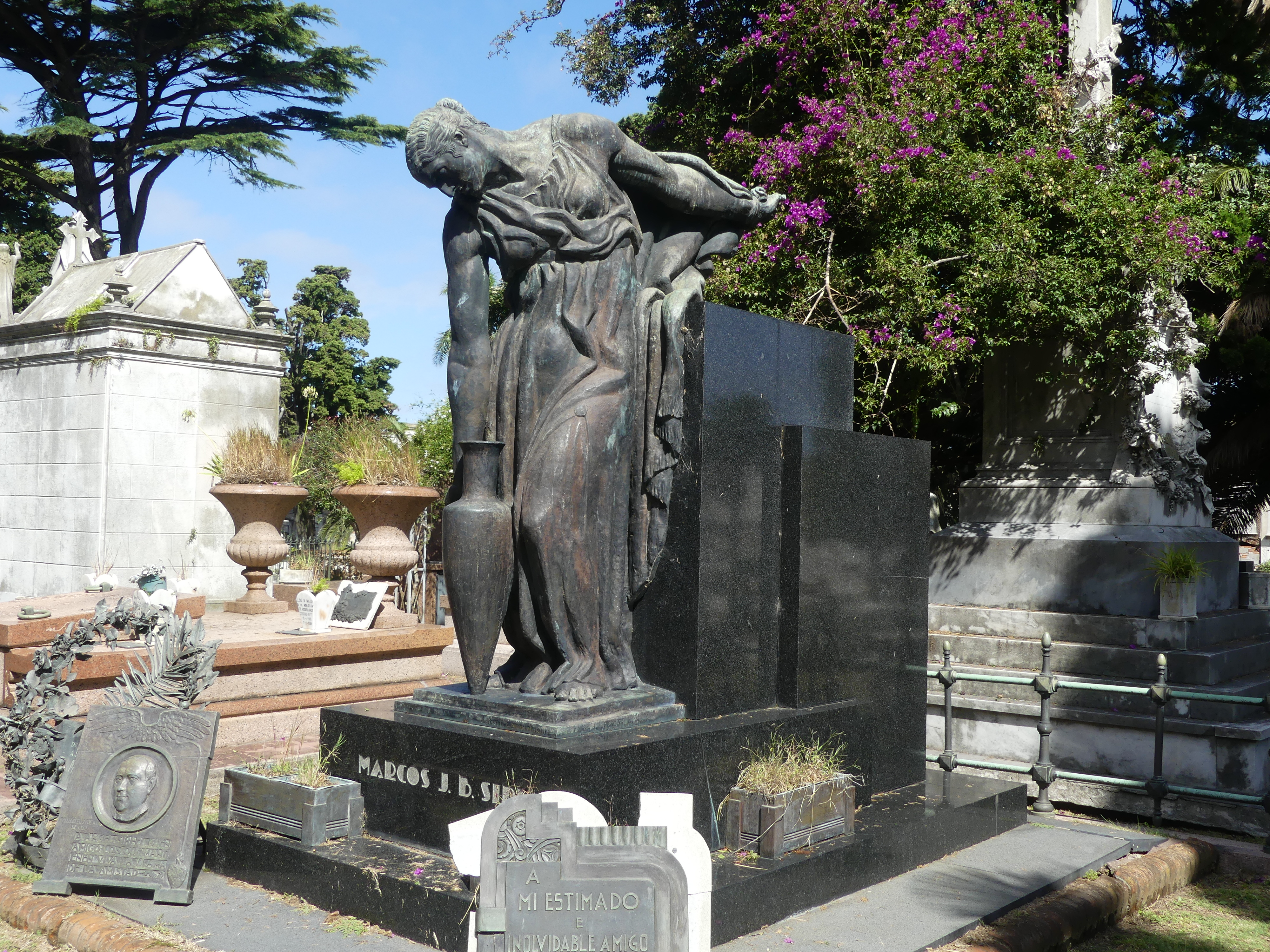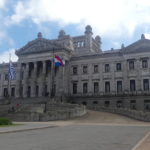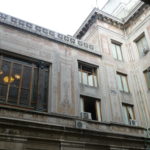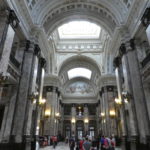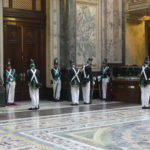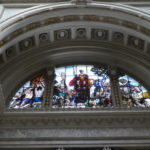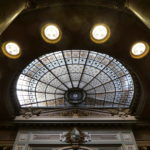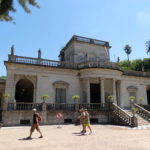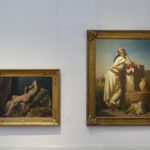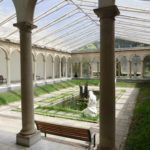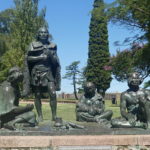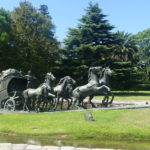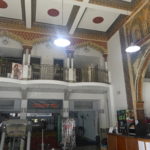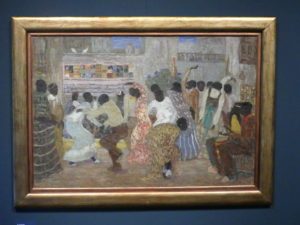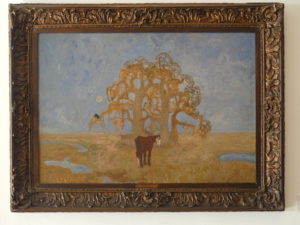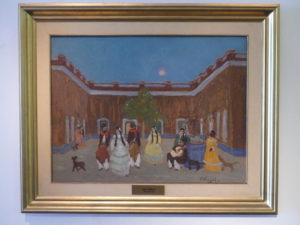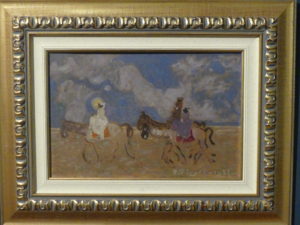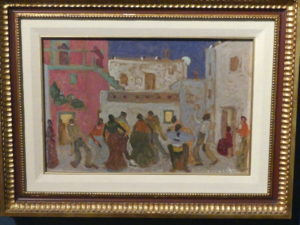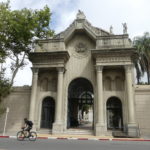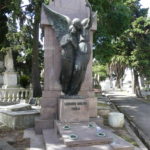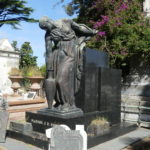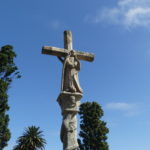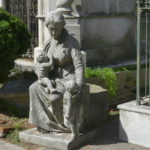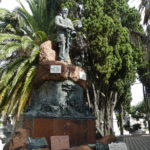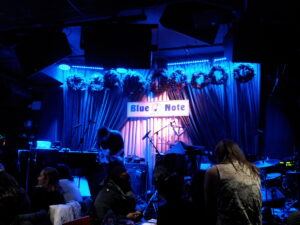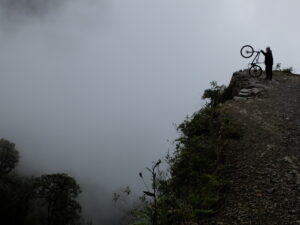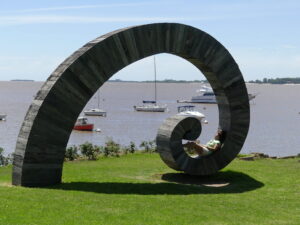Most of our six month stay in Montevideo, we traveled outside the city or lived like other residents. At times, we acted like tourists again – visiting or re-visiting notable places in the city, and learning about famous Uruguayans.
PALACIO LEGISLATIVO
One of the best of the sites was the Legislative Palace, home of Uruguay’s law makers, completed in 1925. Adorned by notable sculptors like Jose Belloni and designed by Italian architects in a blend of neo-classical and Manueline style, this gorgeous building deserved to be called a palace, we thought. The day-to-day entrance is around the side, but the front features a grand arching entrance for dignitaries.
Caryatids on the central tower of the Palace in Manueline style.
The walls of the four interior courtyards are covered in etched sgraffiti, another Italianate feature. Some of it shows its original coloration though much has worn away. Yet the etched lines are still clear.
The central hall includes 27 different types of Uruguayan marble, along with stained glass tableaux and mosaics (above near the back) in the style of Raphael.
Changing of the guard in the central hall at the Palace. The glass case to the far right contains the nearly 200 year old Uruguayan constitution. The floor shows off many of the Uruguayan marbles.
An allegorical stained-glass scene celebrates labor of various sorts high above the central hall.
The house of representatives (in the chamber here) occupies one side of the building. The senate chamber is on the other side. Many of the symbolic designs encourage legislators to do their best and rewards them with this splendid decor. Much of the interior was built in Italy and shipped here for assembly.
Ceiling of the senate chamber.
The richly wooded library of the Palace is open to visits or researchers into the laws. This library owns a copy of every book, magazine and newspaper published in Uruguay – most of which is stored elsewhere in the building.
PRADO
We had already visited Prado, Montevideo’s barrio to the north (a few kilometers away from the Legislative Palace), a tree-lined community of green spaces and large homes. We returned because it’s one of the most appealing parts of the city. You can find peace at its museums, at its large parks filled with masterful sculptures (including a botanical and rose garden), or just by walking its streets to gawk at older mini-mansions. And then there’s the serenity of its small Japanese gardens. Prado has zen!
A former Prado mansion now serves as a museum of art named for the 19th century Uruguayan painter, Juan Manuel Blanes. We came here with some friends we made in Montevideo. Here is where we first met the work of Blanes and the 20th century master Pedro Figari. Some goodies from the inside come later in these photos.
Some of the realist works by Juan Manuel Blanes, on display at his eponymous museum.
Contemporary artists are featured in special exhibitions at Museo Blanes. This is a typical piece by the 20th century abstract painter Teresa Vila.
Covered courtyard at the Museo Blanes, a former mansion.
A compact but diverse Japanese garden sits adjacent to the Museo Blanes. It was developed in the 1920s to honor the friendship between the Japanese and Uruguayans.
A tribute within Parque Prado to Uruguay’s indigenous residents (charruas) who were put on display at a Paris exposition in 1833 and died there. Though the tribe suffered genocide under the first President of Uruguay, this monument also honors the role of these people in fighting for independence against Spain under famed General Artigas.
A dynamic sculpture of early transport by the Uruguayan master Jose Belloni emerges from the edge of Parque Prado, the barrio’s huge open space.
This lobby of an old Moroccan-style movie theatre has been repurposed as a gym. We found it while walking the Prado streets.
PEDRO FIGARI
You’ve likely never heard of Pedro Figari (1861-1938). Nor had we until we kept bumping into the work of this renowned Uruguayan painter in Montevideo. We immediately admired him when we first saw some pieces on exhibit at the Blanes Museum of Art in Prado, a feeling that only grew with more exposure at the Figari Museum in the old town as well as at another extensive exhibit at the Visual Arts Museum (during its special Picasso show drawn from Paris’s Musee Picasso). Figari’s commitment to painting bloomed late in life, but he was prolific. He also found time to write numerous journal articles and amusingly illustrated stories about Uruguayan life. In painting, he adopted a primitive, folksy style, as he celebrated humanity across class structures, including once enslaved Afro-Uruguayans. His themes could even be surrealistic and metaphorical with an approach that reminded us of Rousseau. These photos show just a few of the colorful works we enjoyed.
Candombe. Figari’s crowd scenes are among his best works, replete with a richness of character, detail and vivid enjoyment.
These fluid figures enjoy an evening of candombe, the style of drum-based music and dance they brought to Uruguay.
In the Pampas. This might seem naturalistic, but the gnarled tree and the moon are frequent symbolic characters in Figari’s work, which turns somewhat surrealistic here.
Criollo Dance. A typical Figari scene celebrating the exuberance of communal middle-class life even within its own strictures, represented by the enclosed courtyard. The Figari moon hovers above.
The Bride. This departure from a wedding is roughly sketched, unlike many other robust and crowded wedding scenes Figari painted, but to us it had a kind of sad, symbolic feel we could not shake. Though Figari celebrated Afro-Uruguayan culture and life, he never seemed to question their serving most often in subordinate roles as servants and maids, as with the trailing rider here.
Brutality, or brute life, from the Series, Cave Dwellers. A good example of Figari’s metaphoric work, where the sun-soaked rock seems oppressive, but the dark cave and the skull offer little relief.
Candombe. A partial moon peeks into an outdoor courtyard where Afro-Uruguayans enjoy their native candombe, drum-based music and dance. Clearly Figari returned to the same themes repeatedly, but each depiction is quite individualized.
The cover of a brochure about Figari as a writer and illustrator of stories from everyday life. These charming line drawings also decorate the walls of the Figari Museum, along with displays of his writings.
CENTRAL CEMETERY
We have visited some spectacular cemeteries, like La Recoleta in Buenos Aires or Novodevichy in Moscow or Pere Lachaise in Paris, all filled with ornate statuary and the tombs of famous people. But we felt that the much smaller central cemetery of Montevideo rivaled these in the quality of the sculptural work by Uruguayan artists – even if the graves mainly house famous Uruguayans.
Entrance to the Central Cemetery of Montevideo, a short walk from the old town.
An angel guides the dead soul to heaven, a creation of the notable Uruguayan sculptor José Belloni whose works we saw in the Prado and our neighborhood park, Parque Rodo.
An Art Deco memorial by another famous Uruguayan sculptor, José Luis Zorrilla de San Martín.
This monument looks medieval, and is the oldest work in the cemetery, but dates only from the mid-19th century. It’s been moved around a bit, but now occupies a central place in one section of the cemetery.
We were not quite sure why this statue rested between two graves, but we thought it spoke to life and togetherness rather than afterlife and loss.
The lifelike statue of the General memorialized here was not the interesting part. Click the image to enlarge this photo, and look at the base of the statue, where breathtaking miniatures of his victorious battles are sculpted.
An Art Deco plaque from one tomb
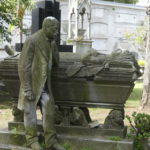
The husband perpetually mourns his dead wife, in contemplative sorrow.
(Also, for more pictures from Uruguay, CLICK HERE to view the slideshow at the end of the itinerary page.)


